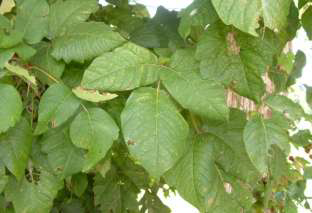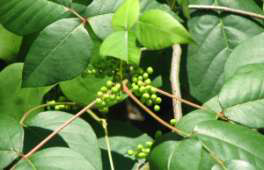 Poison Ivy
Poison Ivy
(Toxicodendron radicans (L.) Kuntze)
|
Classification |
| Kingdom: |
Plantae |
| Division: |
Magnoliophyta |
| Class: |
Magnoliopsida |
| Order: |
Sapindales |
| Family: |
Anacardiaceae |
| Genus: |
Toxicodendron |
| Species: |
radicans |
 Characteristics: Poison ivy leaves consist of three almondshaped leaflets. The color ranges from light green to dark green, turning bright red in fall. The leaflets are 3-12 cm long, rarely up to 30 cm and the leaf surface is smooth. The berries are green, but turn a grayish-white color. The plants can grow as a shrub up to about 4 ft tall, as a groundcover 4-10 in high, or as a climbing vine on various supports. Older vines on substantial supports send out lateral branches that may at first be mistaken for tree limbs. Birds and mammals disperse the fruits. Unconsumed fruits are retained on the plant through winter and are deposited beneath the parent plant in spring. Vegetative expansion by rhizome is a major mode of reproduction in established plants.
Characteristics: Poison ivy leaves consist of three almondshaped leaflets. The color ranges from light green to dark green, turning bright red in fall. The leaflets are 3-12 cm long, rarely up to 30 cm and the leaf surface is smooth. The berries are green, but turn a grayish-white color. The plants can grow as a shrub up to about 4 ft tall, as a groundcover 4-10 in high, or as a climbing vine on various supports. Older vines on substantial supports send out lateral branches that may at first be mistaken for tree limbs. Birds and mammals disperse the fruits. Unconsumed fruits are retained on the plant through winter and are deposited beneath the parent plant in spring. Vegetative expansion by rhizome is a major mode of reproduction in established plants.
Habitat: It is usually found in wooded areas, especially along edge areas. It also grows in exposed rocky areas and in open fields.
Range: Poison ivy grows vigorously throughout much of North America, including all states except Alaska.
Native American Uses: The Cherokee Indians used a poison ivy decoction as an emetic. In addition, it was used in tonics and as a dermatological aid for boils.
Modern Uses: Don’t! The reaction caused by poison ivy, urushiol-induced contact dermatitis, is an allergic reaction. For those who are affected by urushiol, it causes a very irritating rash. The first symptom of contact is a severe itching of the skin that develops into reddish colored inflammation or non-colored bumps, and then blistering of the skin occurs. If poison ivy is burned and the smoke then inhaled, this rash will appear on the lining of the lungs, causing extreme pain and possibly fatal respiratory difficulty. If poison ivy is eaten, the digestive tract and airways will be affected, in some cases causing death. According to the FDA, in case of known contact, exposed skin needs to be cleaned within 10 minutes of contact with rubbing alcohol, then washed with water only then take a shower with soap and warm water. Folk remedies for poison ivy include crushing the stems of jewelweed./p